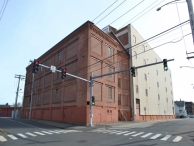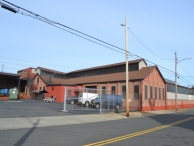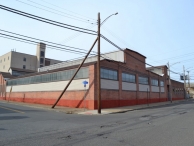Mill Record Bridgeport
RETURN TO ‘FIND MILLS’Disclaimer: Content for these properties was compiled in 2014-2017 from a variety of sources and is subject to change. Updates are occasionally made under Property Information, however the Connecticut Trust for Historic Preservation (dba Preservation Connecticut) makes no representation or warranty that the information is complete or up-to-date.
- Complex Name (Common)
- Bassick Co.
- Complex Name (Historic)
-
- Bassick Co.
- Address or Location
- 275 Warren Street, Bridgeport
- County
- Fairfield
- Historic Designation
- Associated Mill Community
- n/a

- Historic Information
Companies Associated w/Complex
- Bassick Co. 1917-ca. 1946
- Burns & Bassick Co. 1907-1916
- Burns Silver Co. 1895-1907
- Canfield Rubber Co. 1885-1906
- Stewart-Warner Corp. ca. 1930-1962
Use (Historic)
Largest Documented Workforce
300-499 (1939).
Historic Narrative
NOTE: THIS SITE WAS FOUND TO BE ELIGIBLE FOR SR LISTING IN 2022 BY SHPO.The firm that would eventually become the Bassick Company was originally organized as the Burns Silver Company in New York, New York in 1879. The business, which primarily manufactured furniture and cabinet hardware, was moved to Bridgeport, Connecticut in 1895, where the company occupied a since demolished red brick factory on Railroad Avenue. In 1897, Edgar W. Bassick joined the business as the firm’s secretary, and twelve years later he rose to the position of president. That same year, 1909, also saw the firm’s reorganization as the Burns and Bassick Company. As noted, Edwin W. Bassick served as president, along with Wilber F. Burns as vice president; F.C. Bassick, secretary; and W.R. Bassick, treasurer. In 1906, the Burns and Bassick Company acquired a neighboring plant at the corner of Myrtle and Railroad Avenues that had been erected by the Canfield Rubber Company in 1885, this after the latter firm moved to Housatonic Avenue. The Burns and Bassick Company expanded rapidly during the 1910s as a variety of brass and bronze castings were added to the firm’s catalog. In addition to furniture trimmings, these included automobile hardware, grease cups, and the company’s line of “Feltoid” brand casters. Further growth was facilitated by the company’s acquisition of several other large caster manufacturers, most notable among these being the Universal Caster and Foundry Company of Newark, New Jersey, which was purchased in 1916. The move established the Burns and Bassick Company as the largest caster manufacturer in the world, and a year later the firm and its various branches were consolidated as the Bassick Company. This production capacity was fully devoted to the American war effort during the First World War, during which time the firm turned out 50,000 hand grenades per day. In 1923, the Bassick Company was acquired by the Stewart-Warner Corporation of Chicago, Illinois, another business venture with which Edgar Bassick was associated. The Stewart-Warner Corporation primarily manufactured automobile hardware and the Bassick Company continued to operate as an independent division of the firm. The company’s Bridgeport operations were expanded in 1928 when the West Plant, a massive factory at the corner of Railroad and Howard Avenues was acquired, and ca. 1930, when a die casting plant was established at the corner of Austin and Warren Street. Operations were largely consolidated after the business acquired the former Crane Company plant on South Avenue in Bridgeport in 1946, however the Stewart-Warner die casting plant remained in its Austin Street facility until 1962.
- Architectural Information
Number of Existing Buildings
Roughly six (6) adjoining primary blocks.
Dates of Construction
1885, ca. 1905, ca. 1915, 1920, ca. 1920, ca. 1930, ca. 1960.
Architect
n/a
Builder
n/a
Building Type
Architectural Description
The surviving portion of the former Bassick Company plant (several early buildings locate along Railroad Avenue were demolished during the 1940s) consists of roughly six adjoining primary blocks located on the west side of Warren Street and bounded by Warren Street to the east, Austin Street to the south, Myrtle Avenue to the west, and Railroad Avenue to the north. The oldest surviving building is a three-and-a-half-story, 54’ x 109’ red brick manufacturing block, which was built as a 68’ x 40’ mill in 1885. A later red brick addition was erected adjoining the west, north, and east sides of the block, however the original details remain visible from Myrtle Avenue. These consist of a brownstone block foundation, raised basement level, stone watertable, red brick walls with brick stringcourses delineating each floor, segmental-arched window openings with stone keystones and brick sills, a red brick cornice with large brick corbels, and a pedimented side-gabled roof. The details of the ca. 1920 addition include a raised basement level, red brick walls, large rectangular window openings with steel lintels, a red brick cornice with large brick corbels, and flat and low-pitch hipped roof sections. A one-story, 44’ x 22’ red brick boiler plant was erected adjoining the east elevation of the ca. 1920 block at the same time as or shortly following its completion. The boiler plant has brick pier walls, tile coping, and a flat roof. A five-story, 168’ x 60’ reinforced concrete factory block was erected adjoining the south elevation of the 1885 building in 1920. This has red brick apron walls, small rectangular window openings with concrete sills, and a flat roof. The majority of the building has been sheathed with corrugated metal siding, this obscuring its original details on all but a portion of the east elevation. A one-story, 82’ x 32’ steel-frame shipping block adjoins the east elevation of the 1920 block and links it with the two buildings comprising the eastern half of the plant. One of these two blocks consists of a one-story, 148’ x 108’ building standing along Austin and Warren Street. The oldest portion of this block was built as a 32’ x 108’ foundry ca. 1905. This has a concrete foundation, brick pier walls, rectangular window openings with stone sills and lintels, a corbelled brick cornice, and a front-facing gable roof with a nearly full-length gabled clerestory monitor. A cross-gabled addition was erected at the northern end of the foundry ca. 1915, and then the footprint of the overall building was expanded to its present size of 148’ x 108’ when it was converted for use as a die casting plant ca. 1930. The ca. 1930 addition has a concrete foundation, brick pier walls, large ribbon window openings with concrete sills, and a flat roof with both gabled and flat-roofed clerestory monitors. The final block associated with the property was erected adjoining the north elevation of the die casting plant ca. 1960. This consists of a one- and two-story, 158’ x 82’ red brick block with a concrete foundation, red brick walls, small rectangular window openings with concrete sills, concrete coping, and a flat roof.
Exterior Material(s)
Structural System(s)
Roof Form
Roof Material
Power Source
Condition
Fair
Condition Notes
The plant is in fair condition. The vast majority of the window openings have been boarded up or infilled and the 1920 block has been sheathed with corrugated metal siding, however, overall, the various blocks appear structurally sound.
- Property Information
-
Specific Location
One 1.45-acre parcel (275 Warren Street) located on the west side of Warren Street and bounded by Warren Street to the east, Austin Street to the south, Myrtle Avenue to the west, and Railroad Avenue to the north.
Adjacent To
Exterior Visible from Public Road?
Yes
Parcel ID / Assessor Record Link
- 21/ 520/ 1/B / Link →
Acreage
1.45
Use (Present)
- Commercial
- Other: For sale 11/2023. 100k sq ft. Price reduction 4/2024
- Vacant
- Sources
-
Form Completed By
Lucas A. Karmazinas
Date
01/22/2016
Bibliography
- List of Connecticut Manufacturers, 1922, 1924, 1930, 1932.
- Directory of Connecticut State Manufacturers, 1936, 1939.
- Industrial Directory of Connecticut, 1947.
- Register of War Production Facilities in Connecticut, 1951.
- Map of Fairfield County; Baker, William A., 1854.
- Atlas of the City of Bridgeport; J.B. Beers & Co., 1876.
- Atlas of the City and Town of Bridgeport; G.M. Hopkins & Co., 1888, 1917.
- Atlas of Bridgeport; Kershaw, William H., 1910.
- Sanborn Map Company, 1884, 1888, 1898, 1904, 1913, 1939, 1950.
- Aerial Survey of Connecticut, 1934, 1951, 1965, 1970, 1985.
- Bridgeport City Directory, Various editions.
- Bridgeport Telegram, 1954.
- Bridgeport Post, 1962.
- A History of the Old Town of Stratford and the City of Bridgeport; Orcutt, Samuel, 1886.
- History of Bridgeport and Vicinity; S.J. Clarke Publishing, 1917.
- Representative View(s)Click on image to view full file







